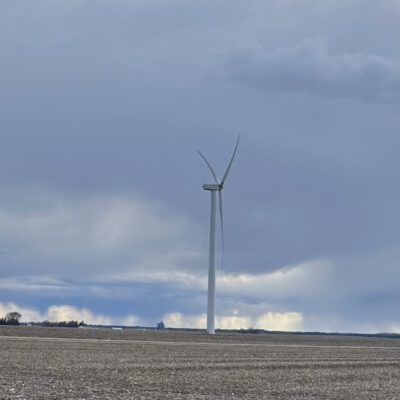
Wendy Johnson, an Iowa farmer and Climate Land Leaders’ Policy Co-Lead, writes with clarity and heart about the challenges of regenerative farming in corn and soybean country. Here’s an excerpt from her recent newsletter. Sign up for her newsletter at Joia Food & Fiber Farm.
One thing I love about Iowa is being able to view sheets of rain along the horizon (Photo A). The site is especially welcomed when it’s been such a rare site the past couple years. Recently it rained and — even though we have been in extreme drought — I witnessed water in the ditches (Photo B). How strange. Shouldn’t the soil be absorbing the rain? At that point, we had only had an inch of precipitation for the month.

Look at the land above the ditch. There is nothing growing in it. The field that is being drained has anhydrous ammonia strips that were applied last fall, so I am going to guess that if I were to test that water flow, it would be full of nitrates. The soil doesn’t have soil stability or aggregates to hold even an inch of water.
How sad is this?
This is why cover crops are important. No-till is important. Perennials are important. Diversity is important. We will never solve our nitrogen problems without all of the above.

Photo C: Imagine this place next to the water full of green forage and trees. Since the 1920s, when landowners got together to build what is called a drainage ditch, trees grew on both sides of the “ditch.” As a child, I grew up playing in what were my only “woods” and fishing bullheads in this creek. I never knew this was a man-made drainage ditch until my dad told me a handful of years ago. With the onset of field tile as a technology to drain former prairie and wetlands, the ditch was built to drain water away from fields. This particular ditch abuts a natural creek and flows eventually into the Cedar River. We all know this story, but as equipment got bigger and there were fewer farmers growing more and more mono crops and field tile was installed spaced every 10 feet across massive fields, there has been an increase in water flowing off the land.

A year ago, some landowners complained about beavers makng dams in the drainage ditch and flooding fields. Meanwhile, a county tile main that drains into the ditch got plugged with tree roots. The county supervisors, who are the trustees of the drainage district, decided to remove all of the trees along the drainage ditch—a seven-mile stretch of gorgeous 80-year-old cottonwood trees and other water-loving varieties. Every landowner in the district had to pay for the removal of the trees. Their portion was defined by the distance away from the ditch and for the excavation and engineering to re-slope the berm onto adjacent land.
For a few months, I cried while I watched the contractor tear down tree by tree and burn those majestic and beautiful cottonwoods. I used to love watching their leaves shimmer like diamonds in the sky. I could hear the trees crying, saying goodbye to this world and all of their friends. For days after, coyotes, deer, eagles, crows, pheasants and other wildlife were confused, looking for a new home.
All of this destruction, just for corn and soybean production.
This story is, unfortunately, a mirror of our times.
So what is left? A sterile, treeless environment, completely controlled so that every acre around can supply corn to the ethanol plant a few miles away. For every soybean to be crushed for protein meal to feed animals in confinement. Who do we think we are? To control, control, control everything that has no voice, so that the land can continue to be deemed valuable for corn production.
In contrast, Photo D brings me so much delight and hope of what can be. Within our riparian buffer, the first trees and shrubs we planted five years ago are tall enough to allow some sheep to graze in and around them. It fuels my fire to keep on my path of diversification on Joia Food & Fiber Farm and help others heal their lands. I get true fulfillment from this work.